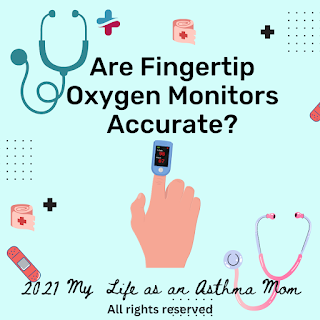Fingertip Oxygen Monitors Not Accurate For Those With Dark Skin
I'm an asthma nerd, and my whole family knows it.
So it shouldn't surprise me when someone says, " Hey, did you see the story about......"
This week's tip comes from The Hubster. He was listening to a radio show that had a story called "Oxygen-Detecting Devices Give Misleading Readings In People With Dark Skin" on All Things Considered.
Over the last 21 years, we have used pulse oximeters to check our kid's oxygen level. When they were little (and frequently in the hospital), we relied on the oximeter to know when to take the kids to the hospital.
But when we got to the ER, the doctors
would lecture us to NOT just rely on the oxygen monitor. But to look at
symptoms instead. They would tell us to watch for the following emergency symptoms:
- If you use quick relief inhaler or nebulizer, and the kid's breathing isn't getting better (or it gets better and then comes back quickly.)
- You see changes in lips or fingernails (bluish or purple color)
- They can't say a full sentence
- Skin is pulling in between the ribs, under the rib cage, or along the color bone (retractions)
- Constant wheezing (remember that not everyone with asthma wheezes - I don't!)
- Steady cough that doesn't get better after using the quick relief inhaler
(Our kids usually had low oxygen levels AND several of the emergency symptoms. And multiple hospitalizations for asthma.....)
This spring, doctors in Detroit started noticing that the fingertip oxygen readings were VERY different from the artery blood draws (that are much more accurate.).
Some people that were struggling to breathe DID have low oxygen levels - even though the finger tip oximeter said the readings were normal. Yikes! They also started seeing a pattern, based on skin color. Dark skinned people were having more wrong oxygen readings than light skinned people. In fact, they said:
"We found that this happened much more often in patients that were Black - basically about three times as often."
Why?
Dr. Michael Sjoding thinks it may have to do with the color of light used in pulse oximeters can be absorbed by skin pigment. He said this wasn't about race - but skin color.
Sounds like these doctors are saying the same thing the ER doctors always told us. Let SYMPTOMS be more important than what an oxygen monitor says. They say that:
"If somebody has coronavirus and they're feeling really short of breath but they're getting a normal number, say an oxygen saturation of 92 to 96% or more, they should pay more attention to their shortness of breath than what that oxygen is being measured."
A fingertip oximeter can be just one tool in monitoring your asthma. Don't rely on JUST that reading. Watch the emergency symptoms too!

Comments
Post a Comment